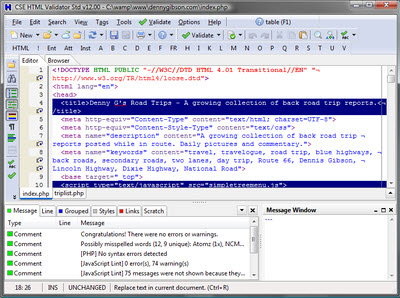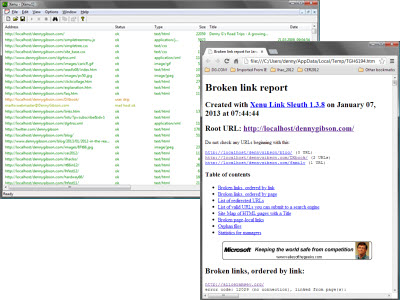When Frontpage Express went away it left a big empty spot in my tool box. FPE was what I initially used to create, edit, and preview webpages. It also allowed me to manage the collection of pages that made up my website and upload the site to the remote server. Microsoft stopped bundling FPE with Internet Explorer at version 6 in 2001. It didn’t immediately disappear but I realized that I best be looking for a replacement. There was, of course, the full blown Frontpage but it was complicated and pricey while my website was simple and I was cheap. Complicated and pricey seemed to describe every all-in-one web tool so I ended up dealing with the four aspects of website management separately.
File Upload
Somewhere inside every web site is an FTP (File Transfer Protocol) server and that is the most basic way to upload files. All versions of MS Windows includes a command line FTP client and I’ve often used that to upload files. I’ve also used some of the fancier FTP clients with graphical interfaces and more powerful features. At some point, MS Windows Explorer became capable of creating FTP connections so that copying to or from a remote file system can be done with the same drag-and-drop cut-and-paste operations as purely local transfers. That’s the way I’ve done uploads for years.
Source Editing
 For at least a couple of years, I maintained the website with the NotePad text editor packaged with MS Windows. The general structure of the website and the layout of the pages had been established with FPE. Adding a new daily page or even a new trip consisted of copying an existing page and modifying it. NotePad handled that just fine. It did not, however, provide much help. There was no spell checking and no syntax checking. Around 2004 or 2005 I started using a program that did both. That program was the free “Lite” version of CSE HTML Validator. It helped tremendously and after a couple of years I purchased the “Standard” version with more powerful error checking and support for CSS and PHP in addition to HTML. These are simply additional programming languages used in webpage authoring. I doubt that many readers of this blog are also writers of HTML but for any that are, CSE HTML Validator is a very good tool worth checking out.
For at least a couple of years, I maintained the website with the NotePad text editor packaged with MS Windows. The general structure of the website and the layout of the pages had been established with FPE. Adding a new daily page or even a new trip consisted of copying an existing page and modifying it. NotePad handled that just fine. It did not, however, provide much help. There was no spell checking and no syntax checking. Around 2004 or 2005 I started using a program that did both. That program was the free “Lite” version of CSE HTML Validator. It helped tremendously and after a couple of years I purchased the “Standard” version with more powerful error checking and support for CSS and PHP in addition to HTML. These are simply additional programming languages used in webpage authoring. I doubt that many readers of this blog are also writers of HTML but for any that are, CSE HTML Validator is a very good tool worth checking out.
Preview and Testing
 As long as I was just dealing with pure HTML, simply pointing a browser at a webpage file was all the preview I needed. Then one forgotten but fateful day I added some PHP or some server side includes and the limits of that method became immediately obvious. Fortunately, by the time I reached this point, many others had already passed it and establishing a local web server was fairly easy. Although my very first web hosts were MS Windows based, I had rather early on switched to Linux. This was not a philosophical or technology triggered switch. It was pure economics. The most common web hosting rig in the world is the Apache server running on the Linux operating system and that’s where the bargains are. It’s cheap because it’s common and common because it’s cheap. To round things out, most of those host providers include, among a mishmash of other tools, bells, features, and whistles, the PHP language preprocessor and the MySQL data base.
As long as I was just dealing with pure HTML, simply pointing a browser at a webpage file was all the preview I needed. Then one forgotten but fateful day I added some PHP or some server side includes and the limits of that method became immediately obvious. Fortunately, by the time I reached this point, many others had already passed it and establishing a local web server was fairly easy. Although my very first web hosts were MS Windows based, I had rather early on switched to Linux. This was not a philosophical or technology triggered switch. It was pure economics. The most common web hosting rig in the world is the Apache server running on the Linux operating system and that’s where the bargains are. It’s cheap because it’s common and common because it’s cheap. To round things out, most of those host providers include, among a mishmash of other tools, bells, features, and whistles, the PHP language preprocessor and the MySQL data base.
Duplicating this common Linux based server model on an MS Windows machine is called WAMP (Windows Apache MySQL PHP) and I’m sure it was pretty messy once upon a time. For me, it was as easy as installing an integrated package from those really smart and generous folks in the world of Open Source. There are several WAMPs available. I’m using the one from WampServer. I like it and have experienced no real problems with it but I’ve no experience with the others so can offer no sort of comparison.
Link Checking
 When I wrote that Frontpage Express “allowed me to manage the collection of pages that made up my website”, what I had in mind was link checking; Verifying that my little piece of the web was coherent with no loose strands leading to no where and no important somewheres with no strands leading to them. The Standard version of CSE HTML Validator, which I own, checks links in individual pages. The more expensive Professional version does this for full websites and other collections, too. The Lite version does neither. I can justify the price of CSE HTML Validator Standard but not Professional. I use the free Xenu’s Link Sleuth. This powerful program checks every internal and external link in a website and produces a full report of errors. It even throws in a complete site map.
When I wrote that Frontpage Express “allowed me to manage the collection of pages that made up my website”, what I had in mind was link checking; Verifying that my little piece of the web was coherent with no loose strands leading to no where and no important somewheres with no strands leading to them. The Standard version of CSE HTML Validator, which I own, checks links in individual pages. The more expensive Professional version does this for full websites and other collections, too. The Lite version does neither. I can justify the price of CSE HTML Validator Standard but not Professional. I use the free Xenu’s Link Sleuth. This powerful program checks every internal and external link in a website and produces a full report of errors. It even throws in a complete site map.
As I’ve said before, there are lots of higher level web authoring tools out there that weren’t even dreamed of in 1999. I am not suggesting that anyone start running a website the way I am. What I am suggesting is that, if you are doing or are considering doing anything similar, these are some pretty good tools to do it with.

My first Web pages were HTML in Notepad. Ah, 1996. Today I use an old version of FrontPage. If FrontPage can’t do it, my site doesn’t have it. I’m so old school.
My Notepad days were sort of in the middle. Frontpage Express was first. By looking at the HTML it generated and doing some reading I eventually reached the point where I could handle the HTML enough to get by with Notepad. “Get by” is still what I do and the CSE Validator just makes it harder — but not too hard — to really screw up.